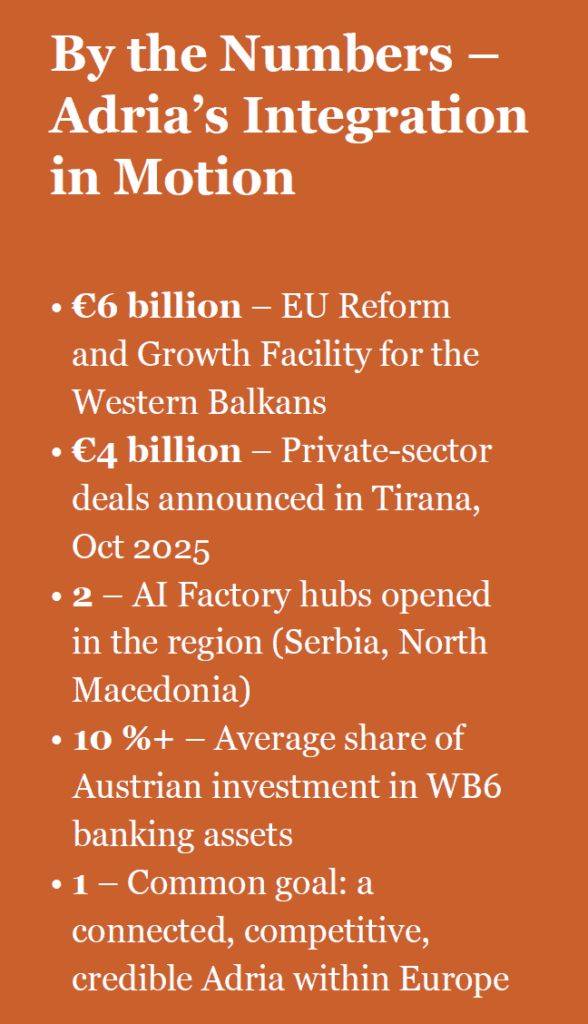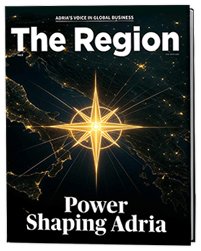How Brussels and Vienna view the region’s next chapter of investment and integration
For once, the most consequential moves in Europe’s geopolitical chessboard aren’t happening in Brussels, Berlin, or Paris—but along the Adriatic. From Ljubljana to Tirana, governments are discovering that the continent’s future balance of influence is being shaped not by speeches, but by the flow of capital, infrastructure, and quiet diplomacy.
1. The €4 Billion
Test When Ursula von der Leyen arrived in Tirana this October, the European Commission President carried a clear message: Europe’s promises must now become projects. At the EU–Western Balkans Investment Forum, she unveiled a package of ten private-sector deals—worth an estimated €4 billion—and a further two dozen under discussion. The investments are the first real proof that the EU Growth Plan for the Western Balkans is not just a policy but a pivot: integrating the region economically before it joins politically.
2. Integration Before Enlargement
The Growth Plan, built on a €6 billion Reform and Growth Facility, offers something new — a path into the EU’s single market sector by sector, as reforms are completed. The logic is pragmatic: open trade, transport, and digital flows now, while accession catches up later. Brussels wants to double the region’s GDP within a decade through reforms and private investment. In practice, it means that a Macedonian freight operator or a Montenegrin tech start-up could soon compete under near-EU rules, long before their countries fly the EU flag.
3. Vienna’s Bridge Strategy
Few capitals understand this experiment better than Vienna. For Austria, the Western Balkans aren’t a neighbourhood — they’re a network. Austrian companies and banks have been embedded in the region for decades, financing everything from energy grids to tourism projects. Raiffeisen and Erste remain among the largest lenders, funding thousands of small and medium-sized enterprises. Vienna’s strategy is clear: if the region prospers, Austria’s stability and export markets do too.
Foreign Minister Beate Meinl-Reisinger has called integration of the Western Balkans “an Austrian security interest.” In practice, Vienna has become a bridge — translating Brussels’ technocratic language into projects and partnerships that local leaders trust.
4. Building Corridors, Not Walls
The new Europe is being built along railways, grids, and fibre cables. Under EU macro-regional strategies like the Danube and Adriatic–Ionian initiatives, infrastructure is being quietly rewired. The rail corridors connecting Belgrade to Bar and Zagreb to Rijeka are being modernised with EU and EIB funds. New interconnectors are knitting the Western Balkan power markets into Europe’s energy system. The message is simple: connectivity is the new diplomacy.
Austria is deeply involved in this process, not only through its construction and logistics companies but as a political sponsor of regional coordination. When Bosnia and Herzegovina chaired the Danube Strategy in 2025, Vienna’s quiet backing ensured the agenda stayed on track despite domestic turbulence.
5. A Digital Leap Forward
Beyond steel and concrete, a quieter revolution is underway. The EBRD and EU jointly launched a €377 million programme to digitalise small and medium-sized firms across the region, funding automation, green innovation, and women-led businesses. Brussels also opened Europe’s “AI Factories” to Western Balkan researchers, starting with hubs in Serbia and North Macedonia. The aim is to prevent another digital divide between the EU and its aspirants.
6. Politics: The Unfinished Variable
Money, however, cannot move faster than politics. Democratic backsliding, judicial bottlenecks, and corruption continue to slow progress. Brussels has tied new funds to clear reform milestones — judiciary independence, procurement transparency, market liberalisation. Some governments complain of over-conditionality; others welcome it as leverage against their own entrenched elites. The region’s credibility now rests on whether these conditions become catalysts or excuses.

7. Europe’s Two Speeds, One Direction
In reality, Brussels and Vienna are playing complementary roles. The EU provides the scale, rules, and funding; Austria supplies proximity, pragmatism, and trust. Brussels pushes for systemic reform. Vienna anchors it in reality. The risk is not rivalry — but misalignment. If the two approaches drift apart, the region could once again become a patchwork of half-finished projects and half-kept promises.
8. The Stakes for 2026
By mid-2026, the first contracts from the Tirana forum will reach implementation. Their success — or failure — will decide whether the Adria region finally joins Europe’s economic bloodstream or remains its waiting room. If the projects advance, Europe will have demonstrated that enlargement fatigue can be replaced by engagement momentum.
In this quiet power game, influence is measured less by summits than by the hum of machinery on construction sites and the click of new payment systems coming online. Brussels provides the vision; Vienna, the pulse. Together, they are redrawing the map of Europe — not with borders, but with connections.
